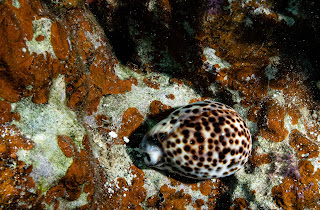The traverse

We entered the water at a site called Andrea 2. It's a beach in an upper-class neighborhood, marked with nothing more than a small rock that had been spray-painted yellow. You could easily miss the site - in fact, we did the first time we drove past. Underwater selfie with my husband, Carl. We hauled our tanks from the gravel parking lot to the beach, past the Australian labradoodle and his Dutch owner lounging in the sun, over the slippery, algae-covered rocks, past the spines of hundreds of sea urchins, onto the sand, and into the waves. Clip, clip, bungee, bungee, right fin, left fin, mask. Dive. I settled into a rhythm pretty quickly. Sometimes, my mammalian dive reflex feels like it takes an eternity to kick in, but today it was right there when I needed it. Long breaths, slow heart beat, perfect neutral buoyancy, lazy kicks. I was in the zone. We swam for three and a half hours. I had never been as far north as Andrea 2, so the first part of the dive was new territory for m





